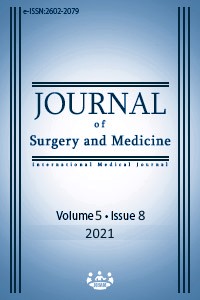Sensitivity and specificity of the modified tandem walking test for vestibular hypofunction with chronic dizziness in young adults
Keywords:
Vestibular hypofunction, Videonystagmography, Modified tandem walking testAbstract
Background/Aim: Patient comfort is greatly affected during videonystagmography (VNG), and more comfortable tests are needed for diagnosis. This study aims to evaluate the modified tandem walking test (MTWT) as an alternative pre-assessment method to the VNG test. Methods: A total of 3348 patients were recruited in this retrospective cohort study between 2015-2019 based on the inclusion criteria of having chronic dizziness (>3 months), being aged between 18-65 years, and having an interpretable VNG test result. All patients were examined by an otolaryngologist, and the examination phase consisted of three parts: Physical examination, VNG test, and performing MTWT. The sensitivity, specificity, and likelihood ratio of the MTWT were calculated with the relevant formulas. Results: The female/male ratio was 2.19, and there was no significant difference between the groups in terms of age (P=0.334). The number of patients who were VNG positive (regardless of MTWT), both VNG and MTWT positive, both VNG and MTWT negative, and VNG negative (regardless of MTWT) were 2519, 2000, 699, and 2519, respectively. The sensitivity and specificity of MTWT were 79.37%, and 84.31%, respectively. Conclusion: MTWT has good sensitivity and specificity, and we think that it can be a safe, simple, and accessible pre-diagnostic tool when VNG is not available or cannot be tolerated by the patients.
Downloads
References
Gill-Body KM, Beninato M, Krebs DE. Relationship among balance impairments, functional performance, and disability in people with peripheral vestibular hypofunction. Phys Ther. 2000;8.
Müjdeci B, Dere H. Vestibular Diagnostic Tests. Ortadoğu Med J. 2016;8:40–6.
Cohen HS, Stitz J, Sangi-Haghpeykar H, Williams SP, Mulavara AP, Peters BT, et al. Tandem walking as a quick screening test for vestibular disorders. Laryngoscope. 2018;128:1687–91.
Longridge NS, Mallinson AI. Clinical Romberg testing does not detect vestibular disease. Otol Neurotol. 2010;31:803–6.
Grace Gaerlan M, Alpert PT, Cross C, Louis M, Kowalski S. Postural balance in young adults: The role of visual, vestibular and somatosensory systems. J Am Acad Nurse Pr. 2012;24:375–81.
Morningstar MW, Pettibon BR, Schlappi H, Schlappi M, Ireland T V. Reflex control of the spine and posture: A review of the literature from a chiropractic perspective. Chiropr Osteopat. 2005;13.
Morimoto H, Asai Y, Johnson EG, Koide Y, Niki J, Sakai S, et al. Objective measures of physical activity in patients with chronic unilateral vestibular hypofunction, and its relationship to handicap, anxiety and postural stability. Auris Nasus Larynx. 2019;46:70–7.
Hall CD, Herdman SJ, Whitney SL, Cass SP, Clendaniel RA, Fife TD, et al. Vestibular rehabilitation for peripheral vestibular hypofunction: An evidence-based clinical practice guideline: From the American physical therapy association neurology section. J Neurol Phys Ther. 2016;40:124–55.
Cunha LCM, Felipe L, Carvalho SA, Labanca L, Tavares MC, Gonçalves DU. Validade da prova calórica monotermal em comparação à estimulação bitermal TT - Validity of the monothermal caloric testing when compared to bithermal stimulation. Pró-Fono R Atual Cien. 2010;22:67–70.
Türkyilmaz MD, Dündar S, Aksoy S. Baş dönmesi şikayeti olan bireylerde baş dönmesi süreǧenliǧi ile depresyon ilişkisinin incelenmesi. Fiz Rehabil. 2013;24:104–9.
van Esch BF, Nobel-Hoff GEAJ, van Benthem PPG, van der Zaag-Loonen HJ, Bruintjes TD. Determining vestibular hypofunction: start with the video-head impulse test. Eur Arch Oto-Rhino-L. 2016;273:3733–9.
Temirbekov D. Current Practice in Vertigo and Dizziness. Curr Pr ORL. 2018;14:10–20.
Kelly EA, Stocker C, Kempton CM, Dierking DM, Fehlberg HE, Adams ME. Vestibular testing: Patient perceptions, morbidity, and opportunity costs. Otol Neurotol. 2018;39:1222–8.
Bush ML, Bingcang CM, Chang ET, Fornwalt B, Rayle C, Gal TJ, et al. Hot or cold? Is monothermal caloric testing useful and cost-effective? Ann Otol Rhinol Laryngol. 2013;122:412–6.
Mezzalira R, Bittar RSM, Bilécki-Stipsky MMDC, Brugnera C, Grasel SS. Sensitivity of caloric test and video head impulse as screening test for chronic vestibular complaints. Clinics. 2017;72:469–73.
Cohen HS, Mulavara AP, Peters BT, Sangi-Haghpeykar H, Kung DH, Mosier DR, et al. Sharpening the tandem walking test for screening peripheral neuropathy. South Med J. 2013;106:565–9.
Blödow A, Blödow J, Bloching MB, Helbig R, Walther LE. Horizontal VOR function shows frequency dynamics in vestibular schwannoma. Eur Arch Oto-Rhino-L. 2015;272:2143–8.
Angeli SI, Velandia S, Snapp H. Head-shaking nystagmus predicts greater disability in unilateral peripheral vestibulopathy. Am J Otolaryngol. 2011;32:522–7.
Cohen HS, Mulavara AP, Peters BT, Sangi-Haghpeykar H, Bloomberg JJ. Tests of walking balance for screening vestibular disorders. J Vestib Res Equilib Orientat. 2012;22:95–104.
Mulavara AP, Cohen HS, Peters BT, Sangi-Haghpeykar H, Bloomberg JJ. New analyses of the sensory organization test compared to the clinical test of sensory integration and balance in patients with benign paroxysmal positional vertigo. Laryngoscope. 2013;123:2276–80.
Cohen HS, Kimball KT. Effectiveness of treatments for benign paroxysmal positional vertigo of the posterior canal. Otol Neurotol. 2005;26:1034–40.
Agarwal K, Bronstein AM, Faldon ME, Mandalà M, Murray K, Silove Y. Visual dependence and BPPV. J Neurol. 2012;259:1117–24.
Miller C, Peters B, Kofman I, Philips T, Batson C, Cerisano J, et al. A comparison of tandem walk performance between bed rest subjects and astronauts. In: 39th Annual Meeting of the American Society of Biomechanics. 2015.
Downloads
- 1768 595
Published
Issue
Section
How to Cite
License
Copyright (c) 2021 Gamze Kılıç, Emre Şenocak, Adem Aktürk, Cengiz Çelikyurt
This work is licensed under a Creative Commons Attribution-NonCommercial-NoDerivatives 4.0 International License.
















